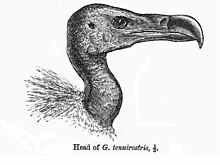| Revision as of 21:08, 7 February 2007 editSnowmanradio (talk | contribs)Autopatrolled, Extended confirmed users, Pending changes reviewers, Rollbackers118,298 edits readability← Previous edit | Revision as of 06:31, 23 February 2007 edit undoDysmorodrepanis~enwiki (talk | contribs)Autopatrolled, Pending changes reviewers75,259 edits taxobox n stuffNext edit → | ||
| Line 1: | Line 1: | ||
| {{Taxobox | |||
| ⚫ | |||
| | color = pink | |||
| | name = Slender-billed Vulture | |||
| | status = CR | |||
| | trend = down | |||
| | image = Gyps_tenuirostris.jpg | |||
| | image_caption = Head of ''Gyps tenuirostris'' | |||
| | regnum = ]ia | |||
| | phylum = ] | |||
| | classis = ] | |||
| | ordo = ] | |||
| | familia = ] | |||
| | genus = '']'' | |||
| | species = '''''G. tenuirostris''''' | |||
| | binomial = ''Gyps tenuirostris'' | |||
| | binomial_authority = | |||
| | synonyms = | |||
| ''Gyps indicus tenuirostris'' | |||
| }} | |||
| The '''Slender-billed Vulture''' ('''''Gyps tenuirostris''''') is a recently recognized ] of ]. For some time, it was lumped together with its relative the ] under the name of "Long-billed Vulture". However, these two species have ] or ] ranges and can be immediately told apart by trained observers, even at considerable distances. | |||
| ⚫ | This species has suffered a marked decline in its numbers in recent years. The only breeding colony of these ]s in South-East Asia in the wild, is in the Steung Treng province of ]. This colony is thought to number about 50 - 100 birds. The survival of the vultures in Cambodia may have been partly because ], which is poisonous to vultures, is not available there. | ||
| ==Conservation== | ==Conservation== | ||
| The Slender |
The Slender-billed Vulture is a protected species listed on the appendix II list of ], because its numbers have declined rapidly. It decline may be partly because of the use of ] drug, diclofenac in working farm animals in especially in ]. Diclofenac is poisonous to Vultures causing kidney failure and is being replaced by ], which is not toxic to Vultures. | ||
| Captive breeding programs in ] are aiming to conserve the species, and it is hoped that vultures can be released back in the wild when the environment is free of Diclofenac. | Captive breeding programs in ] are aiming to conserve the species, and it is hoped that vultures can be released back in the wild when the environment is free of Diclofenac. | ||
| Line 10: | Line 32: | ||
| * | * | ||
| ⚫ | ] | ||
| {{bird-stub}} | {{bird-stub}} | ||
| ⚫ | ] | ||
Revision as of 06:31, 23 February 2007
| Slender-billed Vulture | |
|---|---|

| |
| Head of Gyps tenuirostris | |
| Conservation status | |
| Critically endangered | |
| Scientific classification | |
| Kingdom: | Animalia |
| Phylum: | Chordata |
| Class: | Aves |
| Order: | Falconiformes |
| Family: | Accipitridae |
| Genus: | Gyps |
| Species: | G. tenuirostris |
| Binomial name | |
| Gyps tenuirostris | |
| Synonyms | |
|
Gyps indicus tenuirostris | |
The Slender-billed Vulture (Gyps tenuirostris) is a recently recognized species of Old World vulture. For some time, it was lumped together with its relative the Indian Vulture under the name of "Long-billed Vulture". However, these two species have parapatric or allopatric ranges and can be immediately told apart by trained observers, even at considerable distances.
This species has suffered a marked decline in its numbers in recent years. The only breeding colony of these vultures in South-East Asia in the wild, is in the Steung Treng province of Cambodia. This colony is thought to number about 50 - 100 birds. The survival of the vultures in Cambodia may have been partly because diclofenac, which is poisonous to vultures, is not available there.
Conservation
The Slender-billed Vulture is a protected species listed on the appendix II list of CITES, because its numbers have declined rapidly. It decline may be partly because of the use of NSAID drug, diclofenac in working farm animals in especially in India. Diclofenac is poisonous to Vultures causing kidney failure and is being replaced by meloxicam, which is not toxic to Vultures.
Captive breeding programs in India are aiming to conserve the species, and it is hoped that vultures can be released back in the wild when the environment is free of Diclofenac.
References
This bird-related article is a stub. You can help Misplaced Pages by expanding it. |